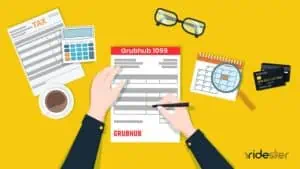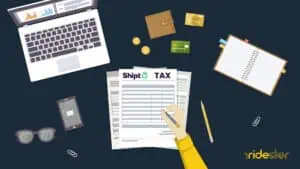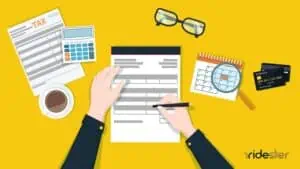Key Information
Independent Contractor Status
Uber drivers are classified as independent contractors. This means they’re responsible for reporting income and following IRS tax laws for independent contractors.
Consequences of Non-filing
Failing to file Uber taxes can result in issues with the IRS and state tax boards. Uber submits forms like 1099-MISC to these agencies, making them aware of your income.
Accessing Tax Forms
Drivers can find their tax information and forms inside the Uber driver dashboard. 1099 forms and an Uber tax summary provide essential details for tax filing.
EIN & Deductions
Uber’s Employer Identification Number (EIN) is 452647441. As independent contractors, drivers can deduct expenses such as mileage, phone costs, and equipment from their tax returns.
Are you driving for Uber and wonder what Uber tax information is and how it all works when filing your tax return?
The first thing to understand is that you’re 100% responsible for taking care of your taxes. Unlike working as an employee, where someone in the human resources (HR) department helps you fill out the tax forms, you’re on your own with Uber.
Uber classifies you as an independent contractor. This status means you have to report your income on your tax return and follow all state and IRS tax laws for people classified in the category of independent contractors.
Don’t worry if this sounds intimidating at first. It’s not as difficult as you might think. In this article, you’ll learn everything you need to know about Uber tax information.
- What Happens if I Don’t File Uber Taxes?
- How to Get Tax Information and Forms from Uber
- What Is the Uber EIN Number?
- What Business Code Is Uber?
- Important Uber Tax Forms
- Where to Get Tax Forms From Uber
- Can Drivers File Uber Taxes Without a 1099?
- Uber Deductions
- How to Fill out Uber Tax Information
- Common Mistakes to Avoid
- Recommended Tax Software for Drivers
- Frequently Asked Questions
- Wrapping Up
What Happens if I Don’t File Uber Taxes?
You’ll end up in trouble with the Internal Revenue Service if you don’t file your Uber taxes.
If you live in a state with a tax board responsible for collecting state income tax from you, then you’ll run into trouble with that entity as well.
The reason is that Uber files a form called IRS Form 1099-MISC with your state agency and with the IRS. They may also file a 1099-K.
These forms include your name, address, and social security number. The IRS and your state tax agency know you made money driving from Uber once the company submits these forms.
How to Get Tax Information and Forms from Uber
The easiest to find your Uber tax information forms is inside your Uber driver dashboard at drivers.uber.com.
Log in and look under the tax forms tab. You should see any 1099 forms that apply to you for the current tax year.
In the same tax settings tab, you can opt in to get your physical copy of your tax documents mailed out to you. You’ll also see an Uber tax summary in your account detailing all the essential tax info you need when filing your taxes.
What Is the Uber EIN Number?
The rideshare app Uber belongs under an umbrella of a corporation called Uber Technologies Inc.
The address of this corp is 1455 Market St, in San Francisco.
The EIN number is 452647441.
An EIN or Employer ID number is a unique number the IRS uses to identify businesses. This ID number will appear on your W-2 or 1099 and tell the IRS which organization paid you a salary. In the case of Uber drivers, this number helps the IRS track how much money you’ve made with the company.
Who Needs the EIN Number for Uber?
It depends on your tax classification. You can drive for Uber with the following tax classifications:
1. Independent Contractors
Uber and Lyft drivers are independent contractors. They report their rideshare earnings as self-employment income. You might receive a 1099 form depending on how much you earn.
2. Driving with an LLC
You have the possibility of creating a limited liability company and reporting your Uber or Lyft earnings as business profits.
It’s an interesting business structure if you want to protect your personal assets or get the benefits of a business bank account. You’ll have to designate yourself as a registered agent of the business.
3. Rideshare Employees
The Supreme Court recently ruled that Uber, Lyft, and other rideshare platforms had to recognize their drivers as employees. This new law ensures that drivers receive a reasonable salary and benefits, including unemployment insurance.
If you drive for Uber in California, your tax status could change in the near future and you would get a W-2. If you receive a 1099 or W-2 from Uber, you’ll find the Uber EIN or Taxpayer’s Identification Number on this form.
There is no need to report it on your tax return. All you have to do is attach your 1099 or W-2 to your 1040 Form.
Why Is the Uber EIN Important?
If you have employee status, the business you work for will withhold FICA taxes from your paycheck. At the end of the calendar year, the IRS will review how much your employer withheld and adjust this amount based on your net income.
You might get a portion of this money back as a tax return. The business entity’s tax ID helps the IRS verify that your employer withheld the amount of taxes you claim on your return and avoid double taxation.
Where to Find The Uber EIN Number
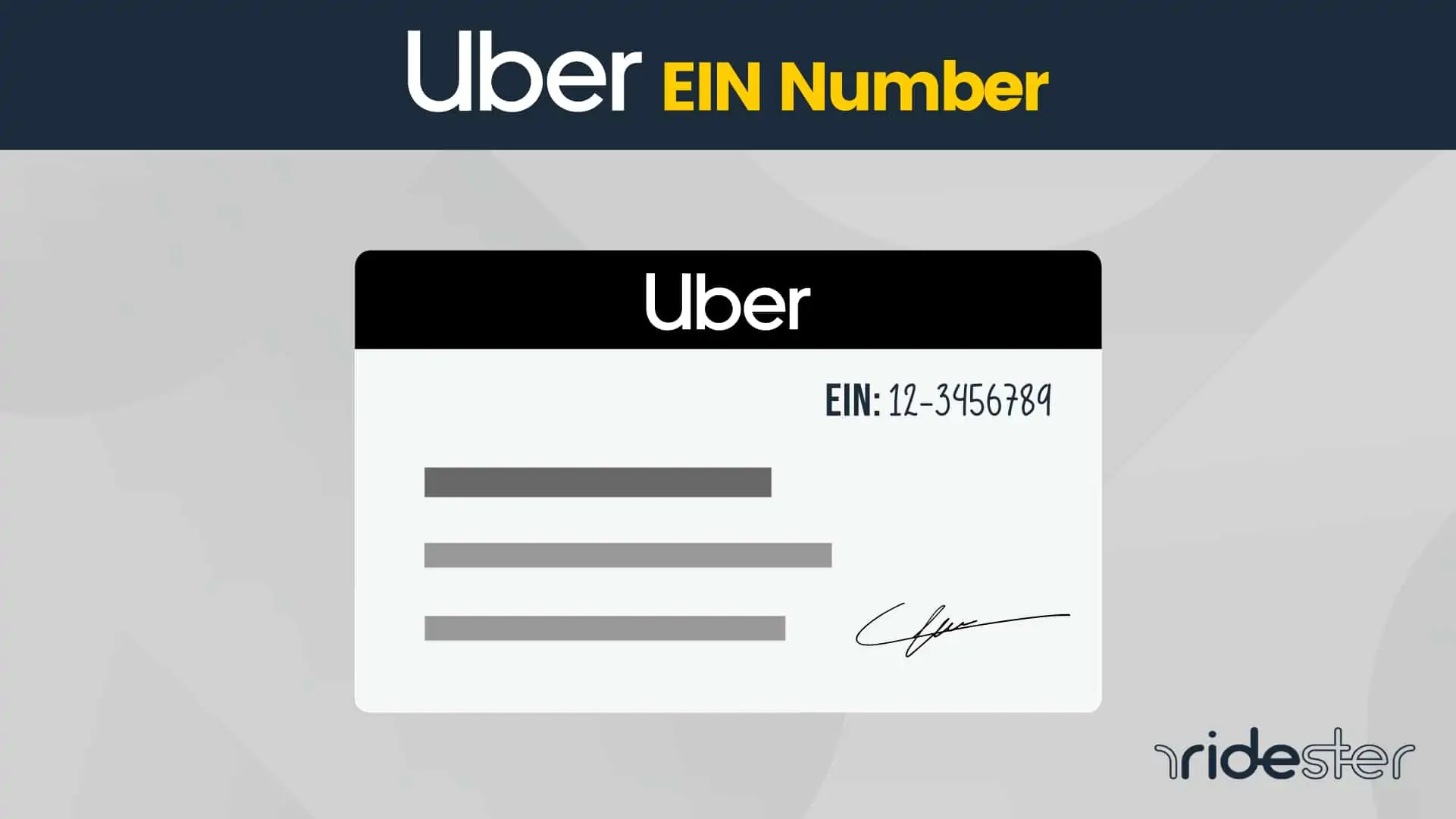
If you receive a W-2 from Uber, look on the second line of the form. You’ll find the Uber EIN next to your wages.
If Uber sends you a 1099 form, you will find Uber listed as a payer. The form has a box for the payer’s TIN underneath the business contact information.
The TIN is the same thing as the EIN, except that Uber technically has the status of a payer and not an employer.
It’s also easy to find Uber’s EIN number online. A number of online databases and directories have this number.
Plus, drivers and Uber enthusiasts will often share the Uber EIN number and additional resources via online communities that operate on social media or on forum software like the Fora platform.
What Business Code Is Uber?
There are different tax classifications for businesses.
When you report your earnings on Schedule C, you’ll find a box at the top of the form that asks for a business code.The purpose of this code is to indicate the general industry in which you work.
The IRS has a comprehensive list of codes on its website where you can look up the one that corresponds to your business activity.If you drive for a rideshare service like Uber or Lyft, you should use code 485300.
If most of your income comes from delivering food with Uber Eats or a similar app, you should use code 492000.
Important Uber Tax Forms
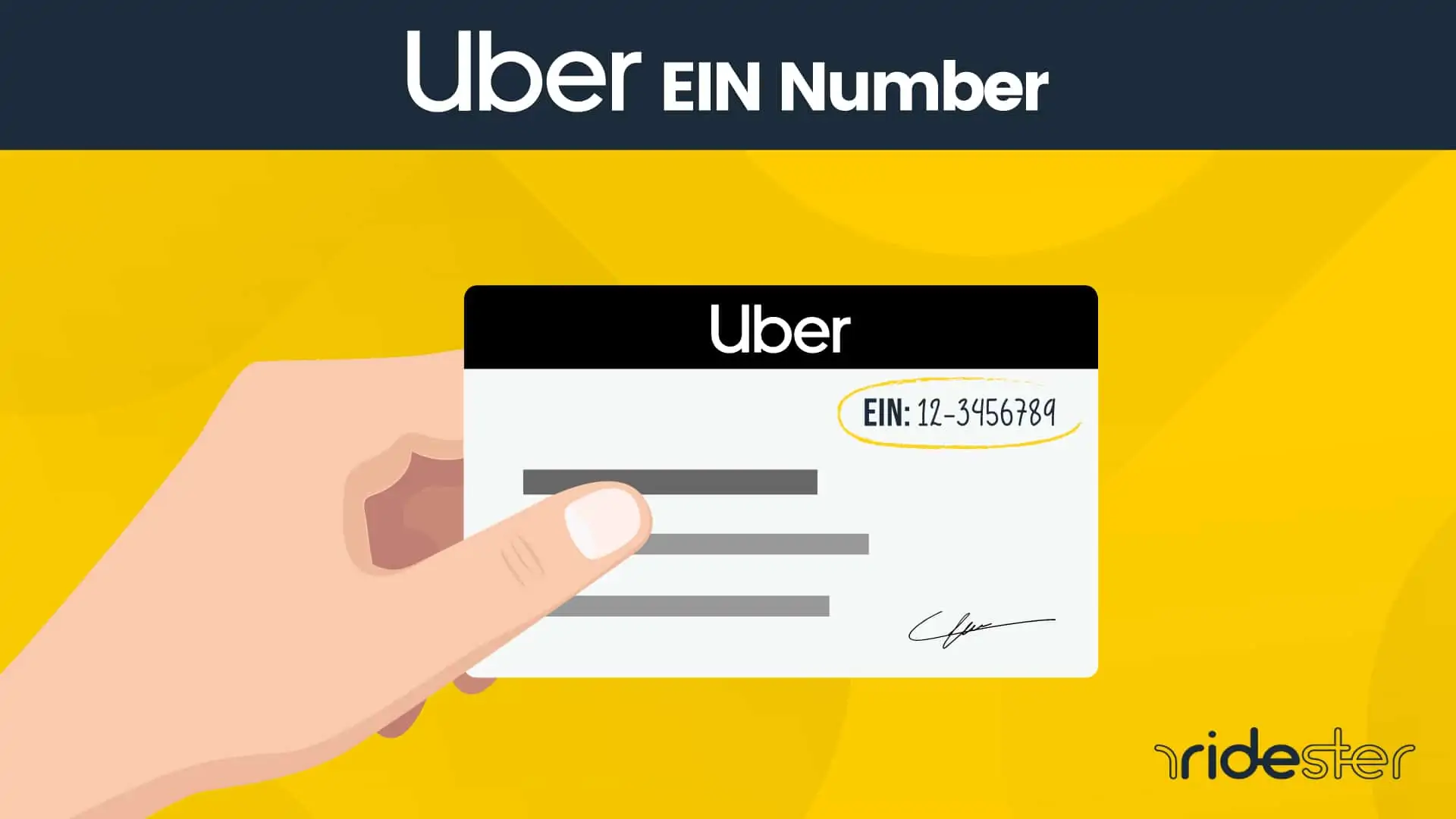
Uber may submit one or all of the following tax forms to tax agencies:
- Form 1099-K
- Form 1099-MISC
- Form 1099-NEC
Form 1099-K reports trip transactions between you and your passengers.
Uber provides this form to you when you’ve done more than 200 rides and earned more than $20,000 throughout the year.
Uber will give you Form 1099-MISC during any year that you earn $600 or more in the categories of Uber sign up bonuses or referral fees.
A 1099-NEC form goes out to you and the IRS if you earned $600 or more from on-trip promotions or referrals.
Where to Get Tax Forms From Uber
Uber drivers in CA could receive their W-2 in the mail in the future.
For now, Uber is issuing 1099 forms if you earn more than $20,000 during the year and log more than 200 trips.
If you earn less, you won’t be able to download your 1099.
You can find your tax forms via the Uber app by following a few basic steps.
Tap on Account, Tax Info, and then Tax Forms.
Note that Uber uploads 1099s before January 31st.
Don’t forget to check that your tax info is correct and edit it if needed.
Can Drivers File Uber Taxes Without a 1099?
Yes, you can file taxes without getting a 1099.
In fact, tax attorneys will tell you that you need to report this income regardless of how much you earn with Uber, even though Uber won’t issue a 1099 until you reach a certain threshold.
Because you’re an independent contractor, Uber doesn’t withhold Social Security and Medicare taxes from your payments.
You need to report this income so you can pay self-employment taxes, which include Social Security and Medicare taxes.
And depending on your situation, you might also have to pay income taxes.
You’ll need to use Schedule C and Schedule SE to report your earnings as a rideshare driver.
You can use the Schedule C tax form to deduct business expenses like car care, accessories for your car, gas, or even classifieds if you drive outside of Uber and advertise your services online.
When you file Schedule SE, you’ll be able to deduct one half of the self-employment tax from your taxable income.
Even though you might not have a 1099 from Uber, you can still submit proof of your earnings by taking a screenshot of the Earnings section of the app.
You can also submit bank statements from personal bank accounts for income verifications that show payouts from Uber.
Uber Deductions
As an independent contractor, you’re able to deduct certain expenses from your tax return.
It’s one of the benefits that W-2 employees don’t get to do.
1. Mileage
You can claim what’s called the standard mileage rate deduction.
There’s a catch to this, however.
If you do use the standard mileage deduction, then you can’t claim other car-related expenses such as gas and repairs.
It’s important to keep proper records about your mileage driven and all your car expenses.
Specifically, keep records of the following:
- Gas
- Lease payments
- Maintenance and repairs (this includes oil changes and tire rotations)
- Depreciation
- Auto insurance
- Vehicle registration fees
- Car washes
With this information, you can determine at tax time whether you’ll save more money deducting your car expenses or by taking the standard mileage rate deduction instead.
You can still deduct money spent on tolls and Uber-related parking fees when you use the standard mileage deduction.
2. Equipment
Independent contractors can deduct equipment used while operating their businesses.
In the case of an Uber driver, your car is your equipment.
That means you’ll deduct the car expense listed in the previous section if you don’t use the standard mileage deduction.
3. Phone and Service
Using your smartphone to drive for Uber is a requirement.
You can’t perform the work without it.
For that reason, the money spent on your monthly cellphone and the cost of a new smartphone is allowable as a deductible expense at tax time.
You can only deduct the amount used during business operations.
You need to separate business use from personal use so that you deduct the correct amount on your tax return.
You should get an itemized phone bill from your cell phone carrier.
It will break down the data and calls made during your working hours.
You can simplify this process by buying a cell phone that you use for your ridesharing work exclusively.
4. Insurance
You can deduct car insurance premiums from your taxable Uber income if you elected not to use the standard mileage rate deduction.
5. Parking, Tolls, Etc.
Similar to auto insurance premiums, gas, and car repairs, you can deduct tolls and parking.
The big difference is that parking and toll fees are still deducted even if you take the standard mileage rate deduction on your return.
How to Fill out Uber Tax Information
Paying a tax expert to help you file taxes is always the safest and easiest route to take, but if you want to save money and do it yourself, you’ll need to be aware of a handful of deadlines — not just the April 15 tax day.
Disclaimer: Please keep in mind this information is provided for general informational purposes only to help you understand Lyft and Uber taxes. It is not intended to be tax advice for any specific individual as all individuals have different tax situations. Ridester advises obtaining tax advice from a Certified Financial Adviser or a Certified Public Accountant who can address your specific situation.
What Tax Documents Do I Need?

1099-K
Banks will often send out a 1099-K to those who have earned over $20,000 or have collected at least 200 payments via Paypal, credit, or debit card.
The IRS started issuing the 1099-K in an attempt to improve tax compliance from independent contractors.
1099-MISC
The Form 1099 variant is an essentially a catch-all for contract workers.
Citizens may receive a 1099-MISC if they earned royalties or if a business has paid them for services rendered.
For example, any physical cash Uber drivers receive from a passenger who writes off the amount as a tax expense.
During such events, Uber drivers will typically receive a 1099-MISC from the business.
If not, they are required to report the earnings on their own via this form.
Schedule C Form
As the sole proprietor of your rideshare business, one of your responsibilities is to mark all expenses and income you handle under the label ‘self-employed’.
Combine the data that you used in the 1099-K and 1099-MISC.
Then, use this data to fill out the Schedule C Form.
Schedule SE
Once you have completed Form Schedule C, the next step is to tackle the Schedule SE.
Uber drivers use this form to calculate how much of their income is taxable.
This amount can be found by subtracting Uber fees and business expenses from your income.
The remaining amount is your net profit.
Plug that number into the Schedule SE form to find out how much self-employment tax is due.
Form 1040
The final document taxpayers need to fill out during the Uber tax filing process is the U.S.
Individual Income Tax Return, or Form 1040.
This document is used to assess all personal clarifications that determine how your income should be processed.
For example, a Form 1040 provides a way for taxpayers to identify spouses and dependents, which may qualify them for additional deductions.
The Uber Tax Filing Process [Overview]
- Collect your 1099 Form
- Rideshare drivers should receive a 1099 form from Uber by January 31st. Your 1099 will show how much money you made and all of the fees that Uber took out of that amount throughout the last year.
- Your 1099 will also display how many miles you have driven in the past year as a rideshare employee. You can access your 1099 by logging into the Uber partner portal.
- Prepare an Expense List
- Compile all of your expenses to maximize the return you get during the tax filing process. Items on this list should include all of the money you spent on improving your rideshare business, such as providing customers with complimentary bottles of water, tire changes, and much more.
- Fill out the Schedule C and Schedule SE Forms
- Once you have put together your tax deduction list, fill out the Schedule C and Schedule SE forms with all of your expenses.
- Calculate Your Total Profit
- The next step is to use your Uber tax information to calculate your total profit for the past year. To achieve this, take the total amount you made, minus Uber fees and business expenses.
- Fill out the Form 1040
- From here, Uber driver taxes are a bit easier to handle. With the 1099 completed, the last two steps are filling out the regular Form 1040 and paying your applicable taxes online or via mail.
Quarterly Estimated Taxes
Since Uber drivers do not get the benefit of withheld taxes, you’ll most likely need to pay estimated taxes throughout the year or face cash penalties for not doing so.
The only exception is if you expect to owe less than $1,000 in total taxes (including taxes you accrue from other gigs).
Quarterly estimated taxes are due four times per year on January 15, April 15, June 15, and September 15 (dates may shift, if they fall on weekends or federal holidays).
Your January 15 payment is always a payment for the previous tax year.
So how do you actually estimate what you owe?
You can use Page 6 of Form 1040-ES for your calculations.
However, if you want to be safe, you can also simply pay 100% of the total taxes you owed in the previous tax year over the course of four payments.
This percentage will need to be 110%, if you are considered a higher income taxpayer, as defined on Page 1 of Form 1040-ES.
To pay your quarterly estimated taxes, you can pay online here with your bank account, credit card, or debit card.
You can also mail in Form 1040-ES with a check or money order.
Alternatively, you can pay by phone at 888-729-1040, 844-729-8298, or 888-872-9829 with a credit or debit card.
Fees may apply depending on your payment method or channel.
Annual Tax Filing
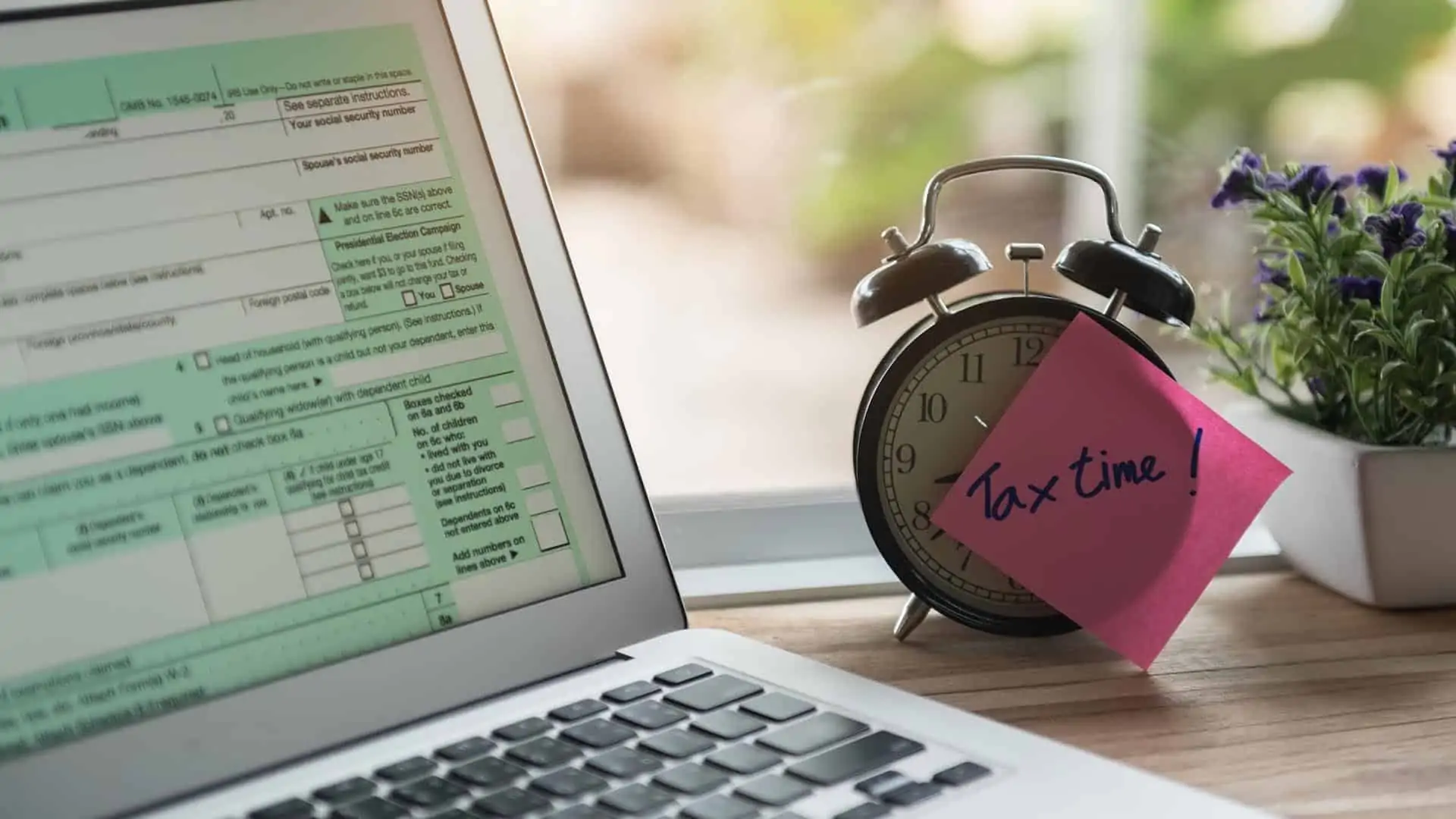
Even after you’ve paid all your quarterly estimated taxes, you still need to complete your annual filings on April 15, along with all other taxpayers.
The first form you need to file is Schedule C (Form 1040).
This is where you’ll be able to report business expenses, so you can get deductions.
Make sure to pay close attention to Schedule C instructions — or use a free online filing program to make things easier — as misrepresenting your expenses can lead to penalties later.
Then, you’ll need to file Form 1040.
This is the most important form that summarizes exactly how much you owe, minus what you already paid in quarterly estimated taxes.
This may be nothing, but more likely you’ll need to pay the difference or you’ll be entitled to a tax refund.
An online filing program or tax software can help you complete this form and set up your payment.
If you live in a state that requires state income taxes, you’ll need to file accordingly as well.
Your state government should provide the right forms on its primary website, or on dedicated treasury or Department of Revenue sites.
Common Mistakes to Avoid

Uber Fees
Driver’s gross income does not include the Uber fees that are instantly removed.
Due to this, it is very common for rideshare employees to calculate expenses without taking the Uber fees into account.
Be sure to only work with the income figure that is generated after you have subtracted Uber’s cut.
Furthermore, do not shortchange yourself.
All Uber fees that you subtracted from your gross income are tax deductible.
Vehicle Expenses
Many rideshare drivers make the mistake of trying to deduct their vehicle expenses twice.
You can avoid this by choosing either the Standard Mileage Deduction or Actual Expense Method before filing.
Drivers that prefer to use the Actual Expense Method should start keeping track of their receipts at the beginning of each year.
Doing so will maximize the total amount of deductions you qualify for during the Uber tax filing process.
Not Saving Enough
Spending money without paying taxes on it first can leave you owing the IRS a hefty amount come tax season.
To avoid this financial nightmare, set aside a portion of your paycheck each week.
Save up this money and do not spend it.
The self-employment tax rate is about 15.3%.
Additional tax rates added to this, such as local, state, and federal, will vary.
To compensate for this, we encourage drivers to set aside 30% of their income for the sole purpose of paying taxes.
Worried you didn’t save enough? Come explore this Uber driving advice to maximize your earnings before tax reason.
Business vs. Personal
As mentioned previously, deducting expenses that border between business and personal use can be tricky.
The IRS will audit you if they suspect that you are trying to deduct personal items instead of business expenses.
To avoid this, make sure you avoid filing personal cell phone data usage and mileage recorded for non-business purposes.
Recommended Tax Software for Drivers
There are many tax filing services online.
Each system offers various features and prices that correlate with the service.
Although there are a few free ways to file your taxes digitally, only a couple of these options include all of the forms that independent contractors need to fill-out.
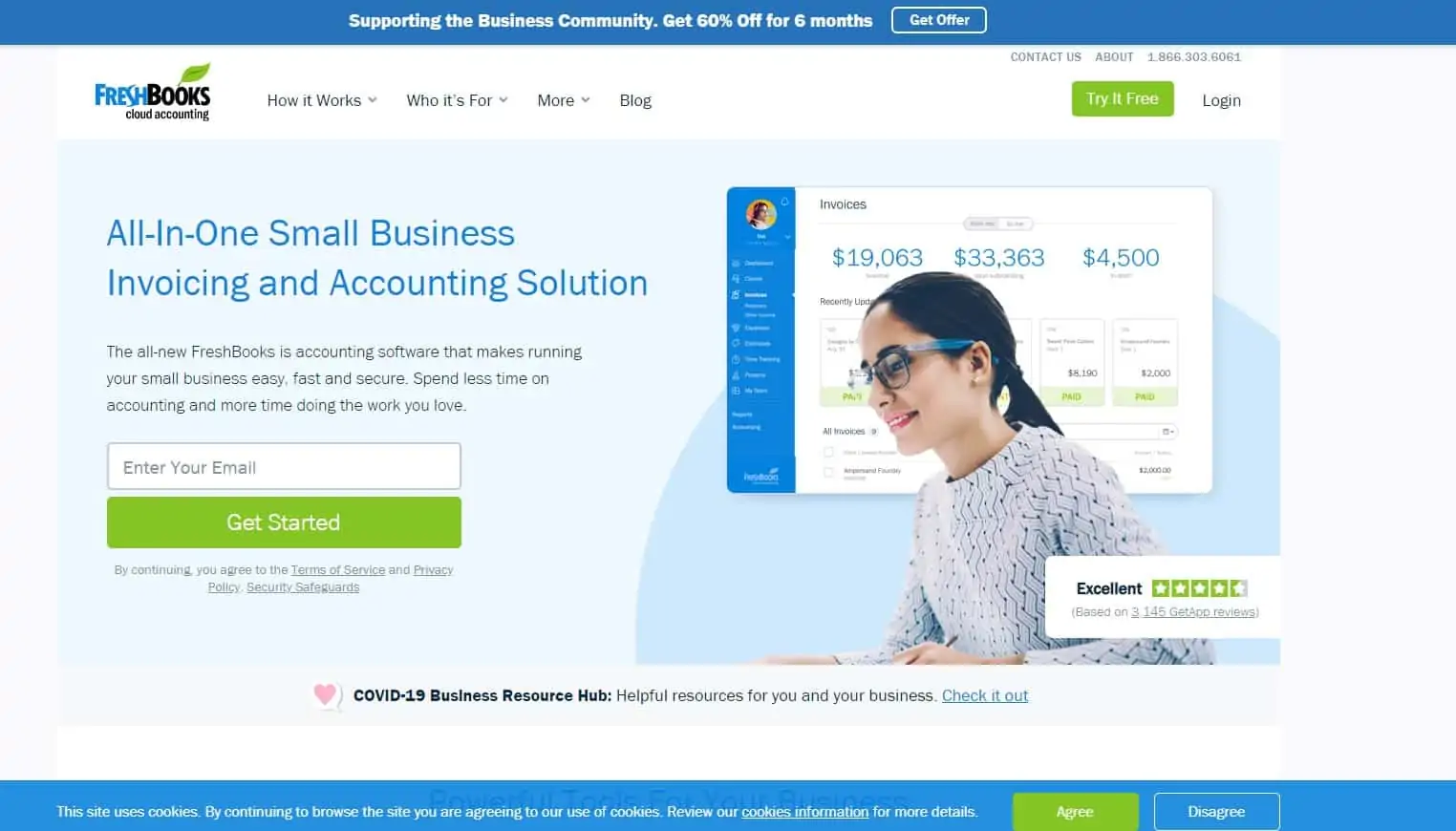
TurboTax
TurboTax uses simple language to guide you through the tax filing process.
The software double checks possible deductions you might have missed and directs you to where to find it.
Pricing for the Self-Employed Version is rather expensive, however, with a federal charge of $114.99 and a $39.99 fee for state.
The best part is the Uber TurboTax partnership, allowing drivers to get discounted pricing just by being a driver.
We highly suggest checking this route out.
H&R Block
Supporting the most tax form coverage and schedules with very few exceptions, H&R Block is another great option for filing taxes.
For starters, they offer several options on how to go about the tax filing process as an Uber driver.
This can be very useful for those who prefer personal, non-automated assistance.
Plus, H&R Block costs significantly less for those filing as self-employed.
Federal is $74.95 and state is an additional $19.95.
TaxAct
Our last recommendation is TaxAct.
Until a few years ago, TaxAct was a free tax filing service that included e-filing service.
TaxAct provides clear, straightforward filing experience at a noteworthy price.
Filing your federal tax return as an independent contractor will cost $37.
The price for filing your state taxes is $25.
Frequently Asked Questions
Taxes are an important responsibility for most workers in the United States, and when you’re an independent contractor, you must be particularly mindful about what you owe.
Get more tax tips by reading our answers to frequently asked questions:

Is Uber considered self-employment?
You’re an independent contractor when driving for Uber.
You need to follow all the tax requirements of a self-employed individual.
That’s why you must attach Schedule C to your Individual 1040 self-employment tax return.
You also need to pay your taxes in quarterly installments throughout the year as an Uber driver.
The IRS and most state tax entities expect sole proprietors to spread their tax payments out in this manner so that you don’t get yourself in trouble at the end of the year.
It’s common for self-employed people to file their taxes each year and discover that they owe a lot of money because they underestimated the total tax due.
Don’t make this mistake because your Uber position might turn into a tax debt situation instead of a positive side hustle situation.
You need to send in a payment on or before the four following dates each year:
1. April 15
2. June 15
3. September 15
4. January 15
Around January 31st or in February, you can start putting your return together.
You’ll file your tax return on or before April 15.
You can report the total amount of tax you already paid from your quarterly payments when you do.
If you estimate correctly, you won’t need to send anything in with your April 15 tax return filing.
If you overestimated and paid too much throughout the previous year, then the IRS will issue you a refund.
Do I need to tell my insurance company that I drive with Uber?
Yes, you must tell your insurance company you drive with Uber.
If you don’t, then you run the risk of having your insurance canceled after suffering through an accident.
If you don’t disclose your work with Uber, your insurance won’t payout if you’re held liable for hurting someone or causing property damage in the accident.
You need to ask yourself if you can afford to pay potentially tens of thousands of dollars out of pocket in that situation.
Does Uber report my earnings to the IRS?
Yes, Uber reports your earnings to the IRS if you earned $600 or more during the year.
That’s how the IRS and state tax agencies find out how much you earned as an Uber driver.
Unless you file a return and list your expenses, you’ll most likely receive a bill from the IRS based on your entire gross Uber income.
That’s not a good place to find yourself in because you aren’t allowing yourself the opportunity to pay tax on a lesser net income.
Can I Use an EIN Number as an Uber Driver?
You can create a rideshare business as a separate tax entity if you want to explore other tax options and possibly lower your tax bill.
It’s a smart move if you have a vehicle that you use only for Uber and Lyft.
Uber and Lyft’s tax policies aren’t clear about how to submit an EIN number when you register as a driver, but there is nothing stopping you from reporting your Uber earnings as a business profit if you have an LLC or sole proprietorship.
Wrapping Up
Obtaining and filling out your Uber tax information isn’t a difficult process.
It requires paying attention to some concepts that might sound new to you if you’ve never worked as a sole proprietor or self-employed individual before.
Read through all the documentation that Uber provides you.
Take the time to read their help files, too.
Uber does a relatively good job of explaining what you need to do at tax time.
Everything will turn out well if you log into your Uber driver app, print out your Uber tax information, use tax software like Tax Act (or hire an accountant for tax advice), and send in the proper tax return forms to the IRS.



